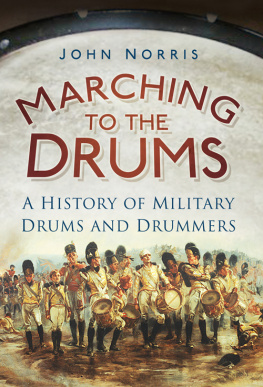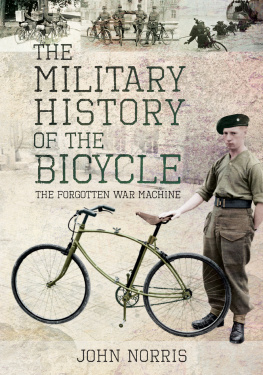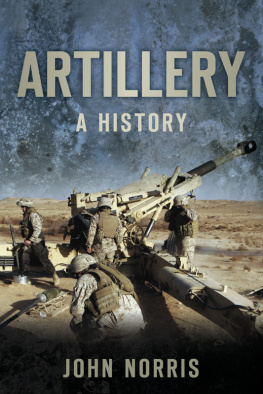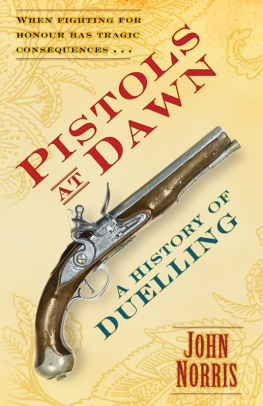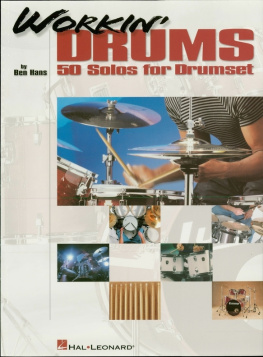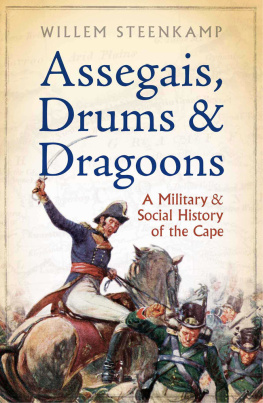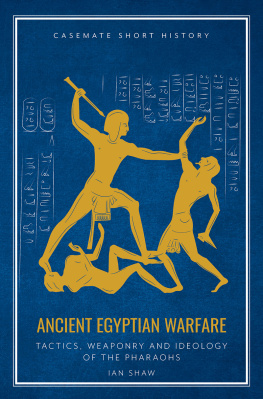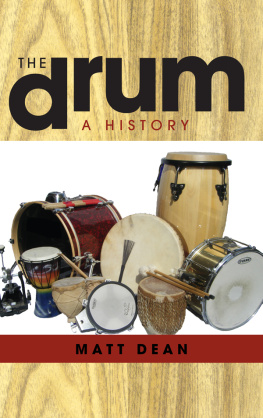
To my grand-daughter, Harriett Eleanor May, whose attempts at playing the drum made amusing diversions during the time spent writing this book.
F irstly I would like to express my gratitude to my wife Elizabeth, who waits patiently and takes notes while I take photographs and talk at length. My thanks go to the many re-enactment groups who have spared the time to speak to me on subjects relating to the use of the drum across the ages and also for allowing me to photograph them for this work. I thank the event organisers where the re-enactments displays are staged, particularly Gary Howard who arranges Military Odyssey. I am also grateful to the staff of regimental museums who have given their time so freely. I would like to thank Jesper Ericsson of the Gordon Highlanders Regimental Museum in Scotland for the images and some background detail on the return of the drums to the regiment. I am most grateful to Michael Cornwall at the Wardrobe Museum in Salisbury for allowing photography and giving me personal explanations of artefacts. My special thanks go to Dave Sands of the Worcestershire Regimental Museum for his support in providing additional material on the black drummers of the 29th Regiment of Foot and for providing illustrations used in the work; Dr Geoffrey Dexter with whom I discussed the use of human skin as drum skins and gave me an idea for the opinion I reached, and Barabara Birley, assistant curator at the Vindolanda Trust at Hexham, for answering the difficult question about Roman army drummers. My thanks go to Captain R.W.C. Matthews, Assistant Regimental Adjutant of the Coldstream Guards, for his time in answering my questions concerning drummer boys. I thank English Heritage and their staff at the sites in their care for making my visits very rewarding. Finally I would like to thank Grahame Gillmore for providing some excellent images, Chris Harmon who talked at length about drummers across the centuries, and the rest of the Diehards who portray the Victorian army with such high levels of authenticity.
C ONTENTS
A s a young boy growing up on Jersey in the Channel Islands during the 1960s, I did many of the same things as some of my school friends, including joining the local Sea Cadet Corps. This organisation offered energetic lads the opportunity to go camping and sailing along with a range of other activities. There was also the corps of drums and as a member of this section of the organisation there came further opportunities such as travelling to England to participate in competitions with other units of Sea Cadets. We probably thought we were good and our long-suffering instructors, despite our undoubted awfulness, nevertheless encouraged us in our endeavours to produce a recognisable tune. Some lads played the bugle and for my part I tried the side drum. I remember thinking how heavy the thing was and how its large awkward size and shape made it unwieldy. Trying to march with the great weight slung over ones shoulder, banging against the left leg, was virtually impossible and I soon asked to go on the cymbals because not only were they easier to play but they were also more manageable, being lighter and smaller.
Over forty years later, reflecting back on those boyhood days it seems incredible to think that there was a time when lads at the age we were in the Sea Cadet Corps had served as drummers in armies and marched into battle while beating out a rhythm to encourage the fighting men. It must have been a terrifying prospect going into battle unarmed and yet these young boys did not flinch. The names of most have long since been forgotten, or were never properly recorded, such as the little French drummer boy trapped inside the slaughterhouse that was Hougoumont Farm during the Battle of Waterloo in June 1815. However, some are still remembered, such as Andr Estienne from Cadenet, France, who was decorated by Napoleon and has numerous statues around France, and there is a handful known from the bloody episode of the American Civil War. As an historian such incidents involving individuals hold more fascination than they would for the passing curiosity of a tourist.
On coming to England after completing my education I joined the Grenadier Guards and once more found myself marching to the beat of drums. This time, however, it was as an infantryman taking part in ceremonies such as Trooping the Colour on Horse Guards Parade in London rather than as a musician. Such parades may seem like so much pomp and ceremony, but such pageantry served a purpose and is part of regimental history. Delving into the role of drums and drummers in military history, one comes to see them in a new and different light. These were brave boys and men who stood shoulder to shoulder with riflemen in battles all across Europe, North America, Africa and Russia. They had to pace out to set an example so that the army would advance and the casualty rate among drummers was extremely high. Even so, they did not flinch and continued about their duties regardless.
The drum is universally regarded as being the most basic of all musical instruments and its use can be traced across the continents from the earliest times and continues today with ceremonial occasions. Thousands of years ago the only way of communicating on the battlefield was by means of visual or verbal commands. Visual signals could be negated by bad weather or the line of sight being interrupted by obstacles such as woods or hills. Verbal commands were only useful for communicating at close quarters and could become ineffective over distance or drowned out by the noise of battle. Over time drums came to be used to relay signals and distinctive commands could be passed on by the echoing thumps on the drum. Brass instruments such as the bugle would eventually come to serve the same purpose as the drum, but that, as they say, is another chapter in military history altogether.
Over the centuries, drums have evolved to become symbols of inspiration, high morale and to signal victory. They have often been used to rally troops for one final effort rather than giving up. The Hussite leader Jan Ziska, 13781424, who campaigned in what is modern-day Bohemia and the Czech Republic, is understood to have ordered that his skin be used to cover the drums so that he may continue to lead his troops in battle after his death. Drums have also been used to signal the shame of an individual being thrown out of the army for actions which do not warrant imprisonment, but the perpetrator still had to be seen to be punished for the sake of discipline. Some drums have passed into legend, such as that taken by Sir Francis Drake on his voyages and which is believed to sound when England needs the assistance of the man who helped defeat the Spanish Armada in 1588.
Among the earliest militaristic societies to use the drum were the ancient Egyptians, who left reliefs carved in stone to depict campaigns in the region of the Sudan and Ethiopia showing drums deployed among the fighting men. For all its militarism the Roman army did not widely use drums, but relied instead on a range of other instruments including horns. It was not until the twelfth century that Europeans were once more exposed to drums when they encountered kettledrums used to relay signals among the ranks of the Saracen armies during the Crusades. Even the Janissaries (taken from the Turkish word yeniceri to mean new troops) as mercenaries in the Turkish armies made extensive use of drums for marching, morale, signalling and to intimidate their enemies.
The Janissary band was called the mehter and its commander was known by the title of Corbacibasi , who was dressed most resplendently, as befitted his rank, in fine attire which included brilliant red robes and a large white turban decorated with peacock feathers. This Turkish formation had a reputation for producing very loud music with trumpets and drums, some of which, the kettledrums in particular, were noted for their enormous size. Such formations accompanied the Turkish army on campaigns, including the war against Hungary in 1526 and in particular the Siege of Vienna in 1529 where it was said that 400 drums were pounding constantly. This would have been an early example of what we today call psychological warfare, designed to undermine morale and weaken resistance. One hundred years earlier, drums had been used at the conclusion of a prolonged siege when Jeanne dArc (Joan of Arc) made a triumphal entry into the French city of Orleans to the sound of trumpets and drums. She, in turn, was only continuing an example set by King Edward III of England who had entered the French city of Calais after the siege in 1347. Apparently Edward had used drums at the Battle of Halidon Hill, where he decisively defeated the Scots in 1333, and thirteen years later at the Battle of Crcy on 26 August 1346 drums were used in battle as the troops moved about the battlefield. The French-born chronicler Jean Froissart (known as John Froissart in English), 13371405, recorded in his works that at the Battle of Crcy the Genoese crossbowmen serving as mercenaries in the French army moved to take up their positions to engage the English army to the beat of drums. Turkish drums had long enjoyed great renown and it was the Swiss mercenaries of the time who spread their influence, the instruments referred to around 1471 as tambour des Perses (Drums of Persia) and included kettledrums.
Next page
